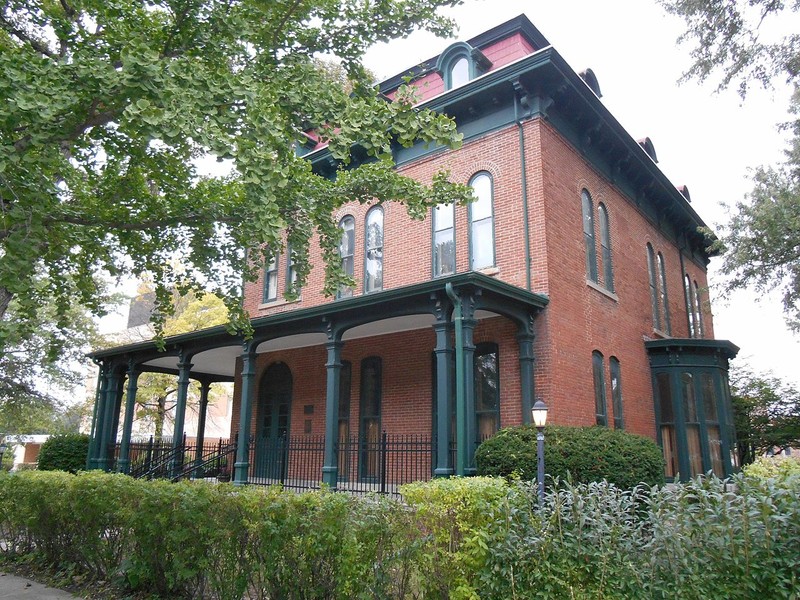Vincent House
Introduction
Text-to-speech Audio
Built in 1872, the Vincent House is the oldest and one of the most historically significant buildings in Fort Dodge. It is named after the Vincent family, who lived here from 1879 to 1969. The family patriarch, Webb Vincent, was a prosperous businessman who was a pioneer of the gypsum industry. The couple who built the house, James and Adeline Swain, were prominent as well. James Swain was a successful pharmacist and businessman. Adeline was a well-known Iowa politician, women's rights advocate, scientist and artist. The house is also notable as a fine example of Second Empire architecture. Today the house is owned by the YMCA and is available to rent for weddings or other gatherings. It was added to the National Register of Historic Places in 1973.
Images
The Vincent House is the oldest structure in Fort Dodge. It was built in 1872 by James and Adeline Swain and occupied by the Vincent family for several decades. Adeline Swain was the leading women's rights activists in Iowa during the 19th century.

Backstory and Context
Text-to-speech Audio
James and Adeline Swain
James and Adeline Swain arrived in Fort Dodge in 1858. In the coming years they established themselves as a leading couple in the community. James found success in the wholesale and retail drug business. They also offered lodging in the house to new arrivals in Fort Dodge and rented the house for a variety of social gatherings including parties and receptions. Adeline was also committed to educating women, offering classes in the house in English, French, botany, oil painting, music, and drawing. A daughter of a school teacher, she learned the importance of obtaining an education and completed hers by the time she was 16. She became a teacher in modern languages and art in a female seminary in Vermont. She and James married in 1858.
Adeline emerged as a prominent political figure in Iowa. She organized the first women's suffrage meeting Fort Dodge in 1869 and during the 1870s, she traveled around the state to promote the cause and establish local suffrage societies. Nationally prominent leaders such as Susan B. Anthony often traveled with her. Adeline was also involved with the National Women's Congress and the National Woman Suffrage Association (she was eventually elected vice president for life of this organization). She also wrote pieces for the national publication called the Women's Tribune. After the Panic of 1873, which forced James into bankruptcy, Adeline joined the Greenback Party since it aligned with her views regarding monetary policy and women's rights. In 1881, she became the first woman in Iowa nominated to statewide office when she was selected as the party's nominee to be Superintendent of Public Instruction. She was also a delegate at the party's national convention 1884.
Adeline made contributions to science as well. She was appointed as a correspondent of the Entomological Commission of the U.S. Department of Agriculture. Her most notable achievement was a report she wrote in 1877 about the devastating effects of the Colorado grasshopper on crops in the Great Plains and western Iowa. She was elected to the American Association for the Advancement of Science for her scientific work, an achievement that was incredibly rare for women at the time. Adeline was the first woman to present a paper at the organization's convention.
Interestingly, the Swains became adherents of the spiritualist movement, whose followers believed they could communicate with the dead. They learned of the movement during a party they hosted. As a result, the house became the meeting place for local spiritualists. In 1874, Adeline was elected state secretary of the Iowa Spiritualist Association. After James died in 1877 (or 1878), Adeline moved (where exactly is unclear but it appears she relocated to Illinois). Webb Vincent and his wife, Catherine, bought the house in 1879.
Vincent Family
Information about Webb Vincent's early life is not readily available but he became one of the leading figures in Fort Dodge in the late 1800s. He was an early supporter of the gypsum industry (gypsum is used to make plaster and stucco, among other products and materials) and also had interests in coal mining and retail merchandising. Vincent was active in the community as well, founding and serving as president of an organization called Associated Charities, which later became known as the Welfare Association.
His son, Donald, married Ann Vincent Roby, who, like Adeline, was also well educated and a women's rights activist. She attended the University of Chicago where she was captain of the women's basketball team. Ann was also an accomplished painter and talented golfer. She and Donald had three children, one of whom died at birth. Ann died in 1969. The YMCA acquired the house by 1973.
Architecture
The house is also historically significant as an excellent example of Second Empire architecture. It features a mansard roof, wraparound porch, and tall arched windows. Inside, the house features tall ceilings, parquet wood flooring on the first floor, a ballroom on the third floor, several fireplaces (including a small one in the children's sitting room), and an usually large number of closets (most people used upright chests at the time). A ballroom is located on the third floor.
Sources
"History of the Vincent House." Vincent House. Accessed March 18, 2022. http://vincenthousefd.octadyne.net/history.
Rufer, Ethyl R. "Vincent House." National Park Service - National Register of Historic Places Nomination Form. April 23, 1973. https://npgallery.nps.gov/NRHP/GetAsset/NRHP/73000743_text.
"Swain, Adeline Morrison." The Biographical Dictionary of Iowa. Accessed March 18, 2022. http://uipress.lib.uiowa.edu/bdi/DetailsPage.aspx?id=372.
Wikimedia Commons: https://commons.wikimedia.org/wiki/File:Vincent_House_01.jpg
